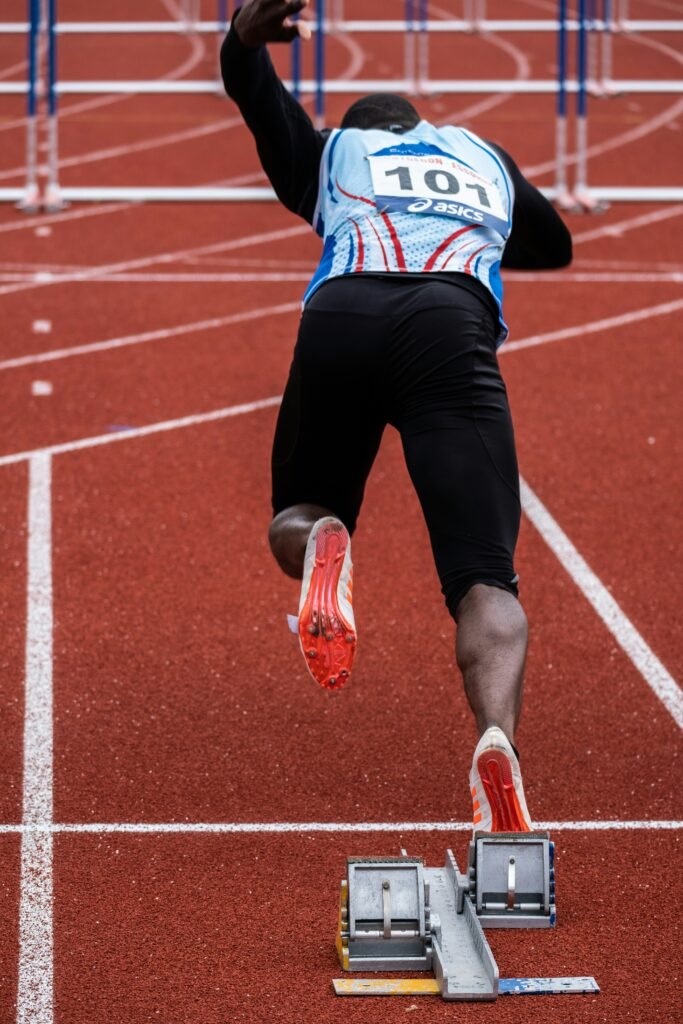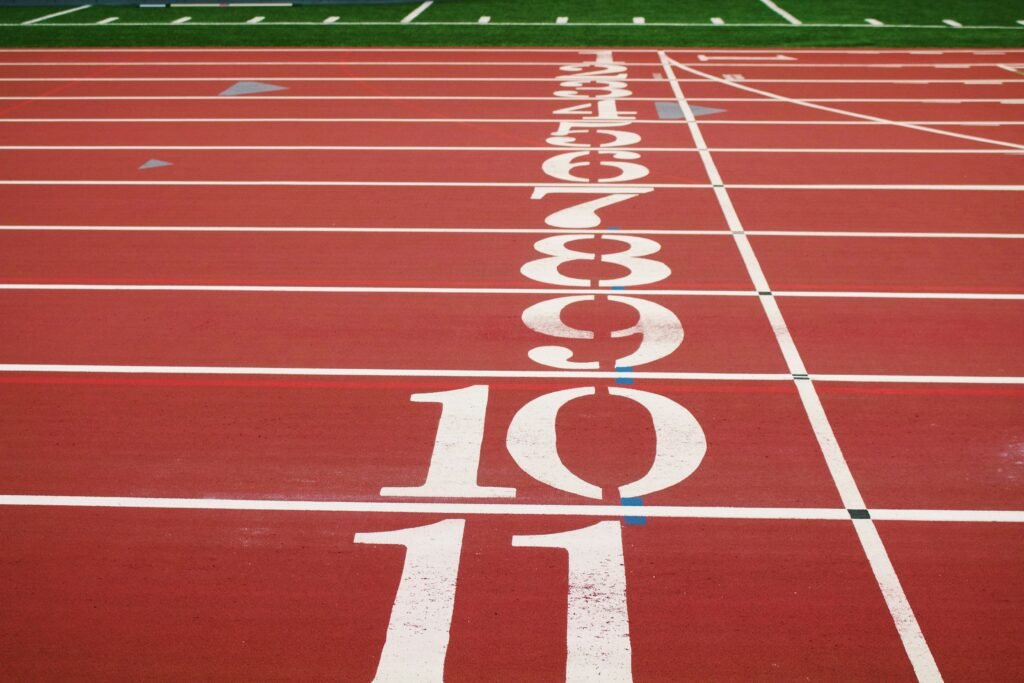Are you ready to experience the thrill of speed and the exhilaration of acceleration? Look no further, because we have the ultimate guide to help you maximize your performance on the fast track to victory. Whether you’re a seasoned racer or just starting out, this article is packed with valuable tips and techniques that will take your speed and acceleration to the next level. From perfecting your technique to optimizing your equipment, we’ve got you covered. So, buckle up and get ready to leave your competitors in the dust as we explore the world of fast track racing.

This image is property of images.unsplash.com.
Choosing the Right Gear
Understanding Gear Ratios
When it comes to maximizing your speed and acceleration, choosing the right gear ratios is crucial. Gear ratios refer to the relationship between the number of teeth on the front and rear gears of your bike. By understanding gear ratios, you can ensure that you are able to pedal at the optimum cadence for maximum power output.
Selecting the Proper Gear
Selecting the proper gear can make a significant difference in your speed and acceleration. The gear you choose should allow you to maintain a steady cadence while providing enough resistance for power. Experiment with different gears to find the one that feels the most comfortable and allows you to reach your top speed without straining.
Using Aerodynamic Components
Aerodynamics play a vital role in enhancing speed and acceleration. Utilizing aerodynamic components, such as an aero helmet or aero bars, can help reduce wind resistance and improve your overall speed. Investing in these components can make a noticeable difference in your performance, especially during sprints or time trials.
Optimizing Body Position
Perfecting the Start
Mastering the start is crucial for maximizing your speed and acceleration. During the initial moments of a race or sprint, the way you position your body can have a significant impact on how quickly you can get up to speed. Position yourself in a crouched position, with your hands on the handlebars and your body leaning slightly forward. This will help you generate power and explode off the line.
Mastering the Sprint
Sprinting requires a specific technique to ensure maximum speed and acceleration. Focus on driving your knees up high, maintaining a forward lean, and pumping your arms efficiently. This will help transfer power from your lower body to your upper body, propelling you forward with force and speed.
Maintaining Proper Posture
Maintaining proper posture is crucial for optimizing your speed and acceleration. Keeping your body aligned and your core engaged not only reduces drag but also improves your overall efficiency. Practice maintaining a strong, upright posture to ensure that every ounce of energy you exert is used to propel you forward.
Building Explosive Power
Strength Training Exercises
Building explosive power through strength training exercises is essential for enhancing speed and acceleration. Focus on exercises that target the major muscle groups involved in sprinting, such as squats, lunges, and deadlifts. Incorporate plyometric exercises, such as box jumps or jumping lunges, to improve your explosive power output.
Plyometric Workouts
Plyometric workouts are specifically designed to improve your ability to generate explosive power. These workouts involve quick, explosive movements, such as jumping or bounding. By incorporating plyometric exercises into your training routine, you can increase your overall power output, translating to faster sprints and better acceleration.
Developing Fast-Twitch Muscles
The key to maximizing speed and acceleration lies in developing fast-twitch muscles. These muscle fibers are responsible for generating quick, powerful movements. Training exercises that specifically target these fibers, such as sprint intervals and explosive jumps, can help you develop the explosiveness needed for high-speed sprints.
Improving Sprint Technique
Proper Arm and Leg Movements
Improving your sprint technique begins with proper arm and leg movements. Your arms should drive forward and backward in a controlled, efficient manner. Your legs should follow a piston-like motion, driving forcefully into the ground and propelling you forward. Focus on maintaining a smooth and coordinated movement between your arms and legs to optimize your speed and acceleration.
Maintaining High Cadence
Maintaining a high cadence is crucial for maximizing speed and acceleration. A higher cadence allows for quicker leg turnover, leading to faster sprints. Train yourself to maintain a fast, efficient pedaling rhythm, as this will ultimately translate into faster sprint times.
Optimizing Stride Length
Finding the optimal stride length is a key factor in improving speed and acceleration. While longer strides may seem more powerful, they can actually hinder your performance. Stride length should be balanced, allowing for quick turnover while still providing ample power. Practice finding the sweet spot for your stride length to maximize your sprinting potential.

This image is property of images.unsplash.com.
Enhancing Reaction Time
Visual and Auditory Cues
Enhancing your reaction time involves training your senses to respond quickly to visual and auditory cues. Incorporate drills that involve reacting to specific visual or auditory signals. This can be as simple as reacting to a starting gun or a coach’s cue. By training your body to react quickly, you can ensure a faster start and improved overall performance.
Reaction Drills
Specific reaction drills can help improve your reaction time. These drills involve sudden movements or changes in direction, forcing you to react quickly and explosively. Incorporate exercises such as ladder drills, shuttle runs, or agility ladder exercises to enhance your reaction time and improve your overall speed and acceleration.
Training Coordination
Training coordination is essential for improving reaction time and increasing speed and acceleration. Incorporate drills that require coordinated movements, such as ladder drills or cone drills. These exercises help improve the connection between your brain and muscles, enabling you to react faster and more efficiently during sprints.
Balancing Speed and Endurance
Interval Training
Balancing speed and endurance involves incorporating interval training into your workout routine. Interval training involves alternating periods of high-intensity effort with periods of low-intensity recovery. This type of training not only improves your speed and acceleration but also enhances your endurance and overall cardiovascular fitness.
Incorporating Hill Sprints
Incorporating hill sprints into your training can have a significant impact on your speed and acceleration. Running uphill forces your muscles to work harder, resulting in increased power and explosive strength. By regularly incorporating hill sprints into your workouts, you can enhance both your speed and endurance, making you a more well-rounded athlete.
Eating for Energy
Proper nutrition plays a crucial role in balancing speed and endurance. Fueling your body with the right nutrients before, during, and after workouts can provide the energy needed for optimal performance. Focus on consuming a balanced diet that includes a combination of carbohydrates, protein, and healthy fats to support your training and maximize your speed and acceleration.

This image is property of images.unsplash.com.
Utilizing Sports Psychology
Setting Clear Goals
Utilizing sports psychology techniques is essential for optimizing your speed and acceleration. One key aspect is setting clear, achievable goals. By setting specific targets for your speed and acceleration, you can maintain focus and motivation throughout your training. Make sure to set both short-term and long-term goals to keep yourself motivated and continuously striving for improvement.
Visualizing Success
Visualization is a powerful tool for enhancing speed and acceleration. Spend time visualizing yourself excelling in sprints and races, imagining the movements, the speed, and the feeling of success. Visualization helps train your mind to perform at its best, boosting your confidence and mental preparation for optimal performance.
Practicing Mental Toughness
Building mental toughness is crucial for maximizing speed and acceleration. Endurance sports can be mentally challenging, and developing mental resilience can give you a competitive edge. Practice positive self-talk, employ relaxation techniques, and build mental toughness through challenging workouts to overcome obstacles and perform at your best.
Recovering for Optimal Performance
Rest and Sleep Importance
Recovering properly is essential for maintaining optimal performance and maximizing speed and acceleration. Make sure to prioritize rest and sleep in your training routine. Aim for at least 7-9 hours of quality sleep per night to allow your body to repair and rejuvenate. Additionally, incorporate rest days and easy training sessions into your schedule to prevent overtraining and promote recovery.
Recovery Techniques
Incorporating various recovery techniques can help optimize your performance. These techniques may include foam rolling, stretching, massage, or active recovery exercises. Experiment with different recovery methods and listen to your body to determine which techniques work best for you. Proper recovery will ensure that you are able to train consistently and push your limits in pursuit of better speed and acceleration.
Injury Prevention
Injury prevention is crucial for maintaining consistent training and maximizing speed and acceleration. Prioritize injury prevention by incorporating proper warm-up routines, listening to your body’s signals, and addressing any issues promptly. Additionally, make sure to incorporate strength training exercises that target your inherent weaknesses or imbalances to minimize the risk of injuries that can hinder your progress.
Applying Effective Warm-up Routines
Dynamic Stretching
An effective warm-up routine is essential for optimizing your speed and acceleration. Start with dynamic stretching exercises to activate your muscles and increase blood flow. Dynamic stretches involve controlled movements that mimic the actions you will perform during your workout or sprint. These stretches can improve your range of motion, muscle activation, and overall performance.
Activation Exercises
Activation exercises are designed to activate the muscles used during sprints and improve their readiness. These exercises may include leg swings, hip openers, or resistance band exercises. Activation exercises help wake up the targeted muscles and prepare them for explosive movements, enhancing your overall speed and acceleration.
Progressive Warm-up
A progressive warm-up routine gradually increases the intensity of your movements and primes your body for optimal performance. Start with low-intensity exercises such as jogging or easy cycling and gradually increase the intensity by incorporating strides or short sprints. This progressive warm-up approach ensures that your muscles and cardiovascular system are fully prepared to perform at their best.
Seeking Professional Guidance
Working with a Coach
Seeking professional guidance by working with a coach can significantly enhance your speed and acceleration. A coach can provide valuable insights, personalized training plans, and expert feedback to help you reach your full potential. They can analyze your technique, provide motivation, and guide you through proper training protocols, ensuring that you are on the right track towards achieving your goals.
Getting Biomechanical Analysis
Biomechanical analysis can provide valuable information about your form and technique during sprints. By analyzing your movements in detail, experts can identify any inefficiencies or areas of improvement. Understanding your biomechanics allows you to make targeted adjustments, ensuring that you are using your body’s potential to the fullest and maximizing your speed and acceleration.
Accessing Sports Science Knowledge
Accessing sports science knowledge can give you a competitive advantage when it comes to maximizing speed and acceleration. Stay up to date with the latest research, training methodologies, and scientific advancements in the field of sprinting. By familiarizing yourself with sports science knowledge, you can make informed decisions about your training, recovery, and nutrition, ultimately improving your performance on the track or road.
In conclusion, maximizing speed and acceleration requires a combination of techniques, training methods, and proper guidance. By understanding gear ratios, optimizing body position, building explosive power, improving sprint technique, enhancing reaction time, balancing speed and endurance, utilizing sports psychology, recovering effectively, applying warm-up routines, and seeking professional guidance, you can unlock your full potential and achieve fast track victory. Remember to train consistently, listen to your body, and always strive for improvement. With dedication, perseverance, and the right tools, you can take your speed and acceleration to new heights.
